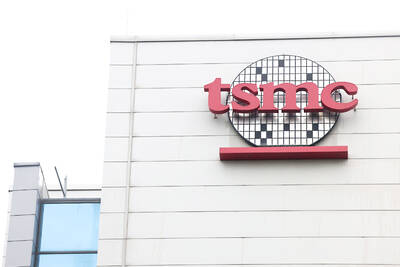The TAIEX moved sharply higher yesterday, the first trading session after the Lunar New Year holiday, to close at a new high, as the market tried to catch up with the strong gains in US markets during the break.
The bellwether electronics sector was behind the upturn, led by global contract chipmaker Taiwan Semiconductor Manufacturing Co (TSMC, 台積電), which continued to advance after a nearly 10 percent rise in its American depositary receipts (ADRs) during the holiday, dealers said.
The TAIEX ended 559.89 points, or 3.54 percent, higher at 16,362.29 on turnover of NT$413.177 billion (US$14.56 billion).

Photo: Chen Chih-chu, Taipei Times
Yesterday’s increase was the second-highest single-day rise in the market’s history, trailing only the 590.19 points jump on Nov. 29, 1989.
“Today’s solid gains were no surprise as investors here were encouraged by high-flying tech stocks, especially in the semiconductor industry, during the break,” Concord Securities Co (康和證券) analyst Kerry Huang (黃志祺) said.
Huang was referring specifically to the Philadelphia Semiconductor Index, which rose more than 7 percent during the break in Taiwan.
“In particular, TSMC, whose ADRs soared during the holiday, attracted strong buying at a time when semiconductors have become a critical material in the global economy,” Huang said.
TSMC rose 4.91 percent to close at NT$663. The stock contributed about 264 points to the TAIEX’s gains, and helped the electronics sector and the semiconductor sub-index rise by 4.09 percent and 5.19 percent respectively.
“Other large cap semiconductor stocks also got a boost, sending the electronics sector even higher during the session,” Huang said.
“Judging from the movement of these tech heavyweights, I think foreign institutional investors stood on the buy side,” Huang added.
Foreign institutional investors bought a net NT$29.69 billion of shares yesterday, Taiwan Stock Exchange data showed.
Non-tech stocks also narrowed their gap with their foreign counterparts, especially the petrochemical sector, Huang said.
China Petrochemical Development Corp (中石化) soared 10 percent to close at NT$10.40 and Formosa Plastics Corp (台塑) gained 7.13 percent to end at NT$96.20.
The financial sector posted robust gains as the yield on benchmark 10-year US Treasury notes kept growing, he said.
Fubon Financial Holding Co (富邦金控) rose 4.26 percent to close at NT$48.90 and Cathay Financial Holding Co (國泰金控) gained 3.33 percent to end at NT$41.95.
“Today’s expanded turnover showed that many investors were willing to chase prices,” Huang said. “In addition, the gains helped the TAIEX overcome stiff technical resistance ahead of 16,239 points, the intraday high on Jan. 21, so I expect the uptrend to continue.”

EARLY TALKS: Measures under consideration include convincing allies to match US curbs, further restricting exports of AI chips or GPUs, and blocking Chinese investments US President Donald Trump’s administration is sketching out tougher versions of US semiconductor curbs and pressuring key allies to escalate their restrictions on China’s chip industry, an early indication the new US president plans to expand efforts that began under former US president Joe Biden to limit Beijing’s technological prowess. Trump officials recently met with their Japanese and Dutch counterparts about restricting Tokyo Electron Ltd and ASML Holding NV engineers from maintaining semiconductor gear in China, people familiar with the matter said. The aim, which was also a priority for Biden, is to see key allies match China curbs the US

The popular Taiwan Semiconductor Manufacturing Co (TSMC, 台積電) arbitrage trade might soon see a change in dynamics that could affect the trading of the US listing versus the local one. And for anyone who wants to monetize the elevated premium, Goldman Sachs Group Inc highlights potential trades. A note from the bank’s sales desk published on Friday said that demand for TSMC’s Taipei-traded stock could rise as Taiwan’s regulator is considering an amendment to local exchange-traded funds’ (ETFs) ownership. The changes, which could come in the first half of this year, could push up the current 30 percent single-stock weight limit

NOT TO WORRY: Some people are concerned funds might continue moving out of the country, but the central bank said financial account outflows are not unusual in Taiwan Taiwan’s outbound investments hit a new high last year due to investments made by contract chipmaker Taiwan Semiconductor Manufacturing Co (TSMC, 台積電) and other major manufacturers to boost global expansion, the central bank said on Thursday. The net increase in outbound investments last year reached a record US$21.05 billion, while the net increase in outbound investments by Taiwanese residents reached a record US$31.98 billion, central bank data showed. Chen Fei-wen (陳斐紋), deputy director of the central bank’s Department of Economic Research, said the increase was largely due to TSMC’s efforts to expand production in the US and Japan. Investments by Vanguard International

‘SACRED MOUNTAIN’: The chipmaker can form joint ventures abroad, except in China, but like other firms, it needs government approval for large investments Taiwan Semiconductor Manufacturing Co (TSMC, 台積電) needs government permission for any overseas joint ventures (JVs), but there are no restrictions on making the most advanced chips overseas other than for China, Minister of Economic Affairs J.W. Kuo (郭智輝) said yesterday. US media have said that TSMC, the world’s largest contract chipmaker and a major supplier to companies such as Apple Inc and Nvidia Corp, has been in talks for a stake in Intel Corp. Neither company has confirmed the talks, but US President Donald Trump has accused Taiwan of taking away the US’ semiconductor business and said he wants the industry back